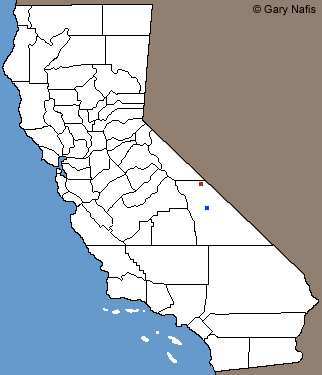 Red:
Red: Range in California
Blue: Introduced population
Click on the map for a topographical view
Map with California County Names
Listen to this toad:

One short call
|
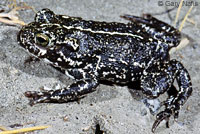 |
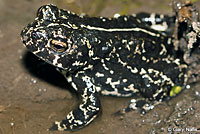 |
 |
| Adult, Inyo County |
Adult, Inyo County |
Adult, Inyo County |
 |
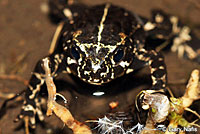 |
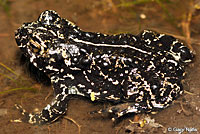 |
| Adult, Inyo County |
Adult, Inyo County |
Adult, Inyo County |
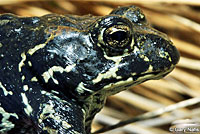 |
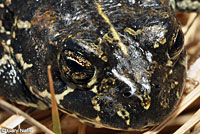 |
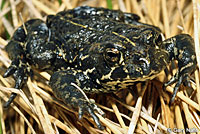 |
| Adult, Inyo County |
Adult, Inyo County |
Adult, Inyo County |
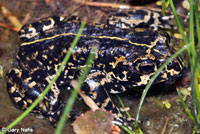 |
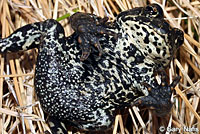 |
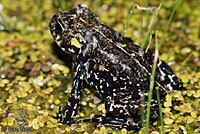 |
| Adult, Inyo County |
Adult underside, Inyo County |
Adult, Inyo County |
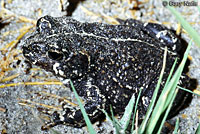 |
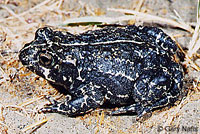 |
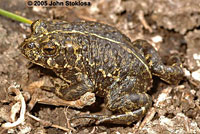 |
| Adult, Inyo County |
Adult, Inyo County |
Adult, Inyo county,
© 2005 John Stoklosa |
 |
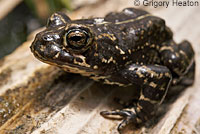 |
 |
Newly metamorphosed juvenile, Inyo County. © Ceal Klingler
|
Adult, Inyo County © Grigory Heaton |
Adult, Inyo County © Grigory Heaton |
| |
|
|
| Breeding, Eggs, and Tadpoles |
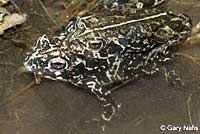 |
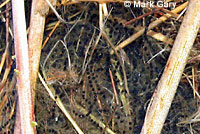 |
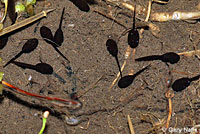 |
| Male and female in amplexus |
Eggs, Inyo County © Mark Gary |
Recently-hatched tadpoles, Inyo County |
See more pictures and videos of breeding Black Toads, eggs and tadpoles here,
Listen to the sounds of Black Toads here.
|
| Habitat |
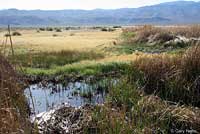 |
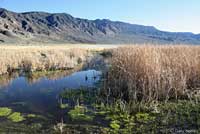 |
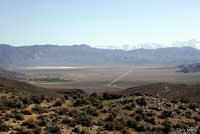 |
| Habitat, Inyo County |
Habitat, Inyo County |
Distant view of Deep Springs Valley,
Inyo County
|
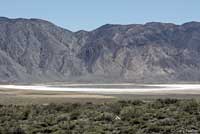 |
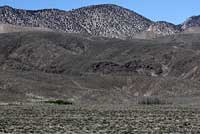 |
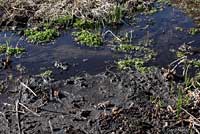 |
Deep Springs Valley, Inyo County, showing dry lake and springs in distance.
|
Distant view of another spring in
Deep Springs Valley |
Black Toads blend in well with this dark mud that makes up much of their habitat, especially at night. (There are no toads in this picture.) |
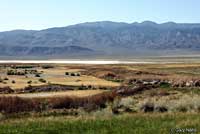 |
|
|
View of toad habitat, Inyo County
|
|
|
| |
|
|
| Short Videos |
 |
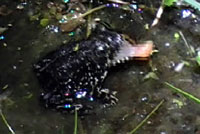 |
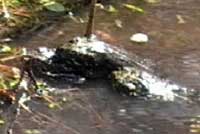 |
| Black Toads crawling around in the water at night. |
A Black Toad lunges with its sticky tongue extended, trying to catch something to eat. |
A solo male approaches a male in amplexus who gives an encounter call. |
 |
 |
 |
| This video shows some of the sounds and activities of Black Toads on the breeding grounds. |
A group of male toads thrash around in the water trying to wrestle away a female away from another male. |
Non-stop ultimate toad-fighting action with a gang of toads trying to steal away females from other males, chasing them around the pond. |
| |
 |
|
| |
A Black Toad eats some ants with its big pink tongue. © Kyla Garten |
|
| |
|
|
|
Description |
| |
| Size |
Adults are 1.75 - 3 inches from snout to vent (4.4 - 7.6 cm). (Stebbins, 2003)
|
|
| Appearance |
The skin is dry and warty, but relatively smooth for a toad.
No cranial crests are present.
Parotoid glands are oval.
|
| Color and Pattern |
Dark, almost solid black above, with light wavy marks and speckles.
Usually has a light stripe down the middle of the back.
Belly is light and heavily blotched with black.
|
| Male/Female Differences |
| Throat is pale, less spotted on males than on females. |
| Young |
Young are olive colored.
|
|
| Life History and Behavior |
| Activity |
Active from March to September, hibernating in rodent burrows near the water during winter.
Diurnal and crepuscular becoming mostly nocturnal during the heat of late spring and summer.
More aquatic than most toads, Black Toads spend most of their time in shallow marshy areas, but they can also be found on dry, sandy soil around springs, foraging among grassy tussocks.
|
| Movement |
| Typical of toads, this one moves slowly, often using a walking or crawling motion along with short hops. |
| Defense |
| As most toads do for defense, this toad relies on parotoid glands and warts which can secrete a poison that deters some predators. They also swim to the bottom to avoid danger. |
| Diet and Feeding |
Eats a variety of small invertebrates.
Prey is located by vision, then the toad lunges with a large sticky tongue to catch the prey and bring it into the mouth to eat. |
| Reproduction |
Reproduction is aquatic.
Fertilization is external, with the male grasping the back of the female and releasing sperm as the female lays her eggs.
The reproductive cycle is similar to that of most North American Frogs and Toads. Mature adults come into breeding condition and move to the water. Males and females pair up in amplexus in the water where the female lays her eggs as the male fertilizes them externally. The adults leave the water and the eggs hatch into tadpoles which feed in the water and eventually grow four legs, lose their tails and emerge onto land where they disperse into the surrounding territory.
Mating and egg-laying occurs from late March into April or May, taking place in shallow water with vegetation to protect eggs and tadpoles. |
| Eggs |
Eggs are laid in shallow waters bordering the larger wetlands.
Eggs are laid in strings which are entwined in aquatic plants on or just below the surface.
Eggs hatch in 5 days. |
| Tadpoles and Young |
Larvae transform 3 - 5 weeks after hatching.
Tadpoles do not overwinter.
Transformed juveniles remain in shallow marshy areas with the adults. |
| Voice (Listen) |
Black toads do not have vocal sacs and do not make an advertisement call. They produce only a weak chirping release or territorial call, similar to the call of the California Toad but higher in pitch. Calls are made during the day and at night. Since it is not made to attract distant females, the call is not very loud.
|
|
| Habitat |
Inhabits springs and marshes in an isolated desert basin between the Inyo and White Mountains. Toads are sometimes found in surrounding grasses. The vegetation around these springs is sparse and conditions are very dry with sandy soil.
|
|
| Geographical Range |
Endemic to California. This toad has one of the smallest ranges of any North American Amphibian. It occurs naturally only in a few spring systems in Deep Springs Valley, Inyo county.
According to a 2004 CA Dept. of Fish & Game report, In 1998, a small introduced population of B. exsul was found in the Saline Valley in Inyo County in Death Valley National Park. Genetics studies by Eric Simandle at the University of Nevada, Reno, determined that these introduced toads originated from springs in Deep Springs Valley.
In 1961, Black Toads were released at Cottonwood Springs in the Owens Valley, about 19 miles from Deep Springs Valley, but they have not been reported from that location again.
Black Toads were also introduced to Batchelder Spring on the west side of Westgard Pass but the population is thought to be extinct. (Macey and Papenfuss, Natural History of the White-Inyo Range Eastern California, 1991, edited by Clarence A. Hall Jr.) |
| Elevational Range |
Occurs at elevations of about 4,900 ft. to 5,600 ft. (1,450 to 1,700 m). (Stebbins, 2003)
|
|
| Notes on Taxonomy |
Formerly included in the genus Bufo. In 2006, Frost et al replaced the long-standing genus Bufo in North America with Anaxyrus, restricting Bufo to the eastern hemisphere. Bufo is still used in most existing references.
--------------------------------------------------------------------------------------------------------------------------------------------------------------------
Related to Anaxyrus boreas, but thought to have been isolated from that species for at least 12,000 years.
--------------------------------------------------------------------------------------------------------------------------------------------------------------------
Nicholson, K. E. (ed.). 2025 SSAR Scientific and Standard English Names List:
"This taxon is nested in the A. boreas group and the entire group is in need of a comprehensive revision to determine species boundaries. Key studies, e.g., Goebel et al. (2009, Molecular Phylogenetics and Evolution. 50: 209–225), Gordon et al. (2017, Zootaxa 4290: 123–139) indicate that the taxon may be nested within A. boreas sensu lato."
--------------------------------------------------------------------------------------------------------------------------------------------------------------------
Alternate and Previous Names (Synonyms)
Inyo Toad
Deep Springs Toad
Bufo exsul - Black Toad (Stebbins 1985, 2003, Stebbins & McGinnis 2012)
Bufo boreas exsul - Black Toad (Stebbins 1954, 1966)
Bufo exsul - Black Toad (Wright and Wright 1949)
Bufo boreas halophilus - California Toad (Storer 1925)
|
|
| Conservation Issues (Conservation Status) |
The population of Black Toads appears to be stable. This toad is listed as threatened because it occurs only in a small isolated population that is restricted to very limited and specialized habitat. If the springs that it depends on were to dry up, or if a disease or predator were introduced, the toad would most likely become extinct.
Deep Springs College and the California Department of Fish and Game cooperate to protect Black Toad habitat by managing water diversions and vegetation around the springs. The college grazes cattle in the winter, when the toads are hibernating, which cuts back vegetation that would choke off toad habitat. Cattle droppings also support insect populations on which the toads feed. In this way, the cattle perform a function once performed by now-absent native grazers such as bighorn sheep and antelope. |
|
| Taxonomy |
| Family |
Bufonidae |
True Toads |
Gray, 1825 |
| Genus |
Anaxyrus |
North American Toads |
Tschudi, 1845 |
| Species |
exsul |
Black Toad
|
(Myers, 1942) |
|
Original Description |
Myers, 1942 - Occ. Papers Mus. Zool. Univ. Michigan, No. 460, p. 3, pl. 1 and 2
from Original Description Citations for the Reptiles and Amphibians of North America © Ellin Beltz
|
|
Meaning of the Scientific Name |
Anaxyrus - Greek = A king or chief
exsul - Latin = exile, refugee - refers to the isolated distribution of this toad
Taken in part from Scientific and Common Names of the Reptiles and Amphibians of North America - Explained © Ellin Beltz
|
|
Related or Similar California Frogs |
Anaxyrus boreas halophilus
|
|
More Information and References |
California Department of Fish and Wildlife
AmphibiaWeb
Hansen, Robert W. and Shedd, Jackson D. California Amphibians and Reptiles. (Princeton Field Guides.) Princeton University Press, 2025.
Stebbins, Robert C., and McGinnis, Samuel M. Field Guide to Amphibians and Reptiles of California: Revised Edition (California Natural History Guides) University of California Press, 2012.
Stebbins, Robert C. California Amphibians and Reptiles. The University of California Press, 1972.
Flaxington, William C. Amphibians and Reptiles of California: Field Observations, Distribution, and Natural History. Fieldnotes Press, Anaheim, California, 2021.
Nicholson, K. E. (ed.). 2025. Scientific and Standard English Names of Amphibians and Reptiles of North America North of Mexico, with Comments Regarding Confidence in Our Understanding. Ninth Edition. Society for the Study of Amphibians and Reptiles. [SSAR] 87pp.
Macey, J. Robert and Theodore Papenfuss."Herpetology." The Natural History of the White-Inyo Range Eastern California.
Ed. Clarence Hall. University of California Press, 1991.
Thelander, Carl G., editor in chief. Life on the Edge - A Guide to California's Endangered Natural Resources - Wildlife. Berkeley: Bio Systems Books, 1994.
Samuel M. McGinnis and Robert C. Stebbins. Peterson Field Guide to Western Reptiles & Amphibians. 4th Edition. Houghton Mifflin Harcourt Publishing Company, 2018.
Stebbins, Robert C. A Field Guide to Western Reptiles and Amphibians. 3rd Edition. Houghton Mifflin Company, 2003.
Behler, John L., and F. Wayne King. The Audubon Society Field Guide to North American Reptiles and Amphibians. Alfred A. Knopf, 1992.
Robert Powell, Roger Conant, and Joseph T. Collins. Peterson Field Guide to Reptiles and Amphibians of Eastern and Central North America. Fourth Edition. Houghton Mifflin Harcourt, 2016.
Powell, Robert., Joseph T. Collins, and Errol D. Hooper Jr. A Key to Amphibians and Reptiles of the Continental United States and Canada. The University Press of Kansas, 1998.
American Museum of Natural History - Amphibian Species of the World 6.2
Bartlett, R. D. & Patricia P. Bartlett. Guide and Reference to the Amphibians of Western North America (North of Mexico) and Hawaii. University Press of Florida, 2009.
Elliott, Lang, Carl Gerhardt, and Carlos Davidson. Frogs and Toads of North America, a Comprehensive Guide to their Identification, Behavior, and Calls. Houghton Mifflin Harcourt, 2009.
Lannoo, Michael (Editor). Amphibian Declines: The Conservation Status of United States Species. University of California Press, June 2005.
Storer, Tracy I. A Synopsis of the Amphibia of California. University of California Press Berkeley, California 1925.
Wright, Albert Hazen and Anna Wright. Handbook of Frogs and Toads of the United States and Canada. Cornell University Press, 1949.
Davidson, Carlos. Booklet to the CD Frog and Toad Calls of the Pacific Coast - Vanishing Voices. Cornell Laboratory of Ornithology, 1995. |
|
|
The following conservation status listings for this animal are taken from the July 2025 State of California Special Animals List and the July 2025 Federally Listed Endangered and Threatened Animals of California list (unless indicated otherwise below.) Both lists are produced by multiple agencies every year, and sometimes more than once per year, so the conservation status listing information found below might not be from the most recent lists, but they don't change a great deal from year to year.. To make sure you are seeing the most recent listings, go to this California Department of Fish and Wildlife web page where you can search for and download both lists:
https://www.wildlife.ca.gov/Data/CNDDB/Plants-and-Animals.
A detailed explanation of the meaning of the status listing symbols can be found at the beginning of the two lists. For quick reference, I have included them on my Special Status Information page.
If no status is listed here, the animal is not included on either list. This most likely indicates that there are no serious conservation concerns for the animal. To find out more about an animal's status you can also go to the NatureServe and IUCN websites to check their rankings.
Check the current California Department of Fish and Wildlife sport fishing regulations to find out if this animal can be legally pursued and handled or collected with possession of a current fishing license. You can also look at the summary of the sport fishing regulations as they apply only to reptiles and amphibians that has been made for this website.
ESA Notes:
Formerly Bufo canorus; Frost et al. (2006. The Amphibian Tree of Life. Bulletin of the American Museum of Natural History 297: 1-370) placed this species in the genus Anaxyrus (Tschudi 1845).
[This appears to be a mistake. It should read "Formerly Bufo exsul."]
|
| Organization |
Status Listing |
Notes |
| NatureServe Global Ranking |
G1 |
Critically Imperiled |
| NatureServe State Ranking |
S1 |
Critically imperiled
|
| U.S. Endangered Species Act (ESA) |
None |
|
| California Endangered Species Act (CESA) |
ST |
Listed as Threatened 6/27/1971 |
| California Department of Fish and Wildlife |
FP |
Fully Protected |
| Bureau of Land Management |
S |
Sensitive |
| USDA Forest Service |
S |
Sensitive |
| IUCN |
VU |
Vulnerable |
|
|
|




































